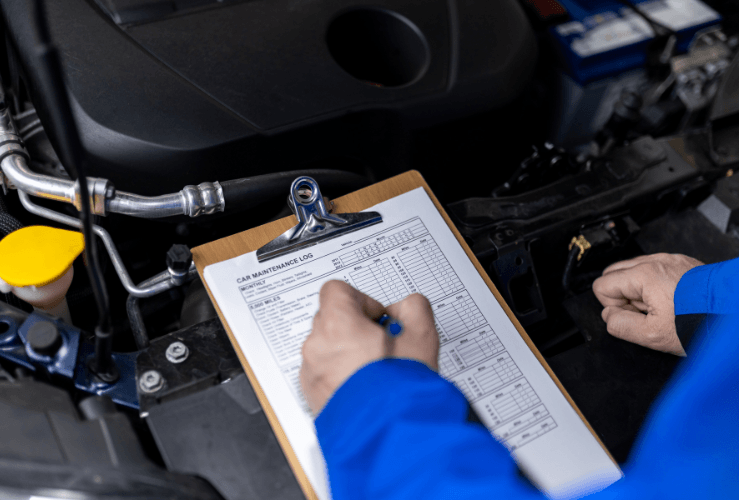Effective ongoing vehicle maintenance directly impacts a fleet’s safety, efficiency - and profitability. Here are five useful tips for keeping your fleet vehicles in excellent working order.
Any enterprise that relies on vehicles for its day-to-day success needs to place effective vehicle maintenance at the heart of its operations.
Neglecting vehicle maintenance may mean fewer resources are used in the short term, but in the medium and long term such an approach will almost certainly result in poorer safety levels, increased breakdowns and more vehicles put out of action - all of which can adversely impact an organisation’s effectiveness, profitability and reputation.
While there are many aspects to effective vehicle maintenance for fleet managers and owners, in this article we’ve pulled together five tips in key areas, to help you keep your fleet running smoothly and efficiently.

Seasonal challenges in the UK
While good fleet maintenance is critical year-round, managers and owners should be mindful of seasonal challenges, and ensure their assets are in excellent working order ahead of time. With this in mind, it’s a good idea to make additional checks before winter sets in, when extra pressure can be placed on components like tyres, electronics and oil systems.
Similarly, with hotter summers in the UK, steps should be taken to ensure vehicles are ready for higher temperatures, with a particular focus on cooling systems, air conditioning, tyre condition, oil, filters and fluid levels.

1. Implement a preventive maintenance schedule
As the old adage goes, prevention is better than cure - and this is certainly true in the realm of fleet management.
It’s far better to resolve small issues as soon as they are identified, rather than reacting once a vehicle has suffered a breakdown.
- Regular Inspections: Schedule routine checks for key components such as brakes, tires, oil levels, and engine performance. Establish who is responsible for these checks - whether the driver, depot staff, or any outsourced mechanical resources.
- Service Intervals: The manufacturer of your vehicles will know best how to keep them in good working order. Refer to the manuals and/or online resources, and adhere to stated service intervals for things like oil changes, filter replacements, and other critical maintenance tasks.
- Software Solutions: You can help to eliminate (or dramatically reduce) human error by harnessing the power of fleet management software. Such packages make it much easier to to track maintenance schedules, particularly with automated reminders for upcoming services and checks.
By staying several steps ahead of your fleet’s maintenance needs, you can reduce the likelihood of unexpected repairs, while extending the lifespan of your vehicles.

2. Prioritise tyre care
It goes without saying that ensuring your vehicles’ tyres are in top condition is essential for the safe and cost-effective operation of your fleet.
Sadly, ‘where the rubber hits the road’ can be overlooked, resulting in poorer fuel efficiency, accelerated wear and tear, and even a higher likelihood of accidents.
- Carry Out Tyre Pressure Checks: Under-inflated or over-inflated tyres can make vehicles more difficult to handle, while increasing fuel consumption (one of the biggest costs of running a fleet). Ensure your vehicles’ tyres are inflated to the pressure levels recommended by the manufacturer.
- Rotate Vehicle Tyres: Rotating a vehicle’s tyres is a relatively inexpensive way to extend the life of your tyres, since it helps distribute pressure more evenly. Doing so will also help reduce vibration noise, benefiting your drivers.
- Keep an Eye on Tread Depth: Worn-out tyres present a very real safety hazard. Regularly check tread depth and replace tyres promptly if they fall below the UK legal limit of 1.6mm.
Investing in high quality tyres from reputable brands - and maintaining them properly - is likely to save your organisation money in the long run, while reducing the likelihood of accidents.

3. Train Your drivers to spot early warning signs
As any seasoned fleet manager knows, skilled and experienced drivers are the lifeblood of your organisation. And since they are on the front line of operations, they are ideally placed to spot problems early on - before they turn into more serious and costly issues.
With this in mind, it's critical you provide sufficient training to your drivers so they can spot the signs of a problem.
- Unusual Noises: Odd sounds often mean a mechanical issue is developing. Ensure your drivers keep an ear out for squealing brakes, grinding gears, or knocking sounds that might indicate underlying issues.
- Warning Lights: While your drivers will already be familiar with the meaning behind the various dashboard warning lights, make it clear that they must act accordingly if one appears.
- Performance Changes: If a vehicle displays a drop in fuel efficiency, becomes difficult to start, or exhibits reduced acceleration - the vehicle should be flagged for inspection as soon as possible.
It’s a good idea to inculcate your drivers with the notion that they are responsible for catching issues before they turn into serious problems.
As well as improving efficiency and cutting costs, remind them that this will also help to keep them safe on the road.

4. Keep detailed maintenance records
It's not easy to keep track of the health of multiple vehicles within a fleet, but accurate record-keeping is at the heart of effective fleet management. Detailed maintenance records not only help you stay organised but also provide valuable insights into the health of your vehicles - helping you make better acquisition decisions.
- Track Repairs and Services: Keep documents for every repair, service, and inspection, including dates, mileage, and of course, costs.
- Identify and Analyse Trends: Use this data to identify recurring issues or vehicles that require frequent repairs, and make informed decisions about replacements or upgrades. Certain makes and models may encounter more issues than others.
- Compliance: Proper records ensure you meet the UK’s legal and regulatory requirements, such as those for roadworthiness and emissions standards such as Euro 6 (which is still in effect post-Brexit).
Digital tools and fleet management software can streamline this process, making it easier, quicker and cheaper to access and analyse a given vehicle’s maintenance history.

5. Invest in driver training/Safety programmes
Our final tip once again relates to your driving team.
The way your drivers operate your vehicles directly impacts maintenance needs. You need to make it clear that aggressive driving, harsh braking and rapid acceleration can all increase wear and tear - and therefore costs.
- Eco-Driving Techniques: Train your drivers to adopt fuel-efficient driving habits, such as smooth acceleration and maintaining a steady speed.
- Defensive Driving: Encourage safe driving practices in relation to other drivers, poor road surfaces and debris. This should reduce the risk of accidents - and help eliminate associated repair costs.
- Give Regular Feedback: Provide drivers with feedback on their performance and, if necessary, offer refresher courses to reinforce good habits. In particular, drivers who exhibit undesirable driving habits should be encouraged to undergo additional training.
Ultimately, by promoting responsible driving, you can reduce maintenance costs, improve fuel efficiency, and enhance overall fleet safety - all of which can contribute to a solid company reputation and a healthier bottom line.
Conclusion
Effective vehicle maintenance is not just about fixing problems—it’s about preventing them from occurring in the first place.
By implementing a preventive maintenance schedule, prioritising tyre care, training your drivers to spot early warning signs, keeping detailed records and investing in training programs, you can keep your fleet running efficiently and cost-effectively.
For UK-based fleet owners, these tips are particularly important given the country’s stringent road safety and emissions regulations. By taking a proactive approach to maintenance, you’ll not only save your organisation money, but also ensure your fleet remains compliant, reliable and ready to meet the demands of your business.
Remember: a well-maintained fleet is a profitable fleet. Start implementing these tips today and enjoy the benefits of smoother operations, reduced costs and happier, safer drivers.



